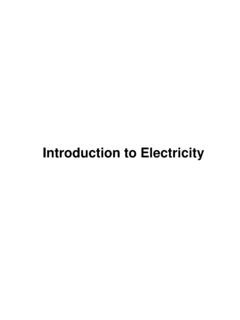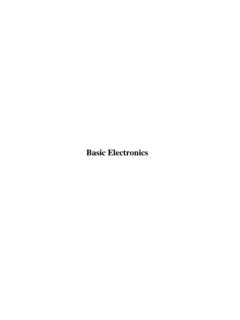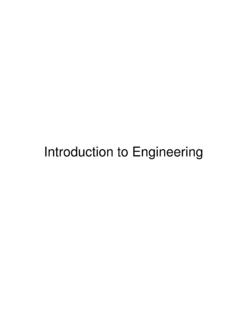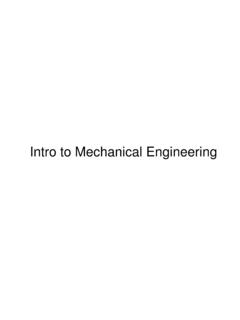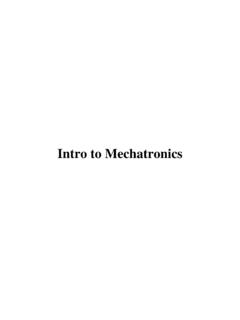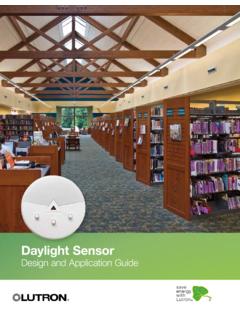Transcription of Intro to Sensors - New York University
1 Intro to Sensors Overview Sensors ? Commonly Detectable Phenomenon Physical Principles How Sensors Work? Need for Sensors Choosing a sensor Examples Sensors ? American National Standards Institute A device which provides a usable output in response to a specified measurand A sensor acquires a physical quantity and converts it into a signal suitable for processing ( optical, electrical, mechanical). Nowadays common Sensors convert measurement of physical phenomena into an electrical signal Active element of a sensor is called a transducer Transducer?
2 A device which converts one form of energy to another When input is a physical quantity and output electrical sensor When input is electrical and output a physical quantity Actuator Piezoelectric: Sensors Actuators Force -> voltage Electrical Voltage-> Force Physical parameter Input => Ultrasound! Electrical Physical Output Microphone, Loud Speaker Output Commonly Detectable Phenomena Biological Chemical electric Electromagnetic Heat/Temperature Magnetic Mechanical motion (displacement, velocity, acceleration, etc.). Optical Radioactivity Common Conversion Methods Physical thermo- electric , thermo-elastic, thermo-magnetic, thermo-optic photo - electric , photo -elastic, photo -magnetic, electro-elastic, electro-magnetic magneto- electric Chemical chemical transport, physical transformation, electro-chemical Biological biological transformation, physical transformation Commonly Measured Quantities Stimulus Quantity Acoustic Wave (amplitude, phase, polarization), Spectrum, Wave Velocity Biological & Chemical Fluid Concentrations (Gas or Liquid).
3 electric Charge, Voltage, Current, electric Field (amplitude, phase, polarization), Conductivity, Permittivity Magnetic Magnetic Field (amplitude, phase, polarization), Flux, Permeability Optical Refractive Index, Reflectivity, Absorption Thermal Temperature, Flux, Specific Heat, Thermal Conductivity Mechanical Position, Velocity, Acceleration, Force, Strain, Stress, Pressure, Torque Physical Principles: Examples Amperes's Law A current carrying conductor in a magnetic field experiences a force ( galvanometer). Curie-Weiss Law There is a transition temperature at which ferromagnetic materials exhibit paramagnetic behavior Faraday's Law of Induction A coil resist a change in magnetic field by generating an opposing voltage/current ( transformer).
4 Photoconductive Effect When light strikes certain semiconductor materials, the resistance of the material decreases ( photoresistor). Choosing a sensor Need for Sensors Sensors are pervasive. They are embedded in our bodies, automobiles, airplanes, cellular telephones, radios, chemical plants, industrial plants and countless other applications. Without the use of Sensors , there would be no automation !! Imagine having to manually fill Poland Spring bottles Motion Sensors Monitor location of various parts in a system absolute/relative position angular/relative displacement proximity acceleration Principle of operation Magnetic, resistive, capacitance, inductive, eddy current, etc.
5 Potentiometer Primary Secondary Optoisolator LVDT Displacement sensor Strain Gauge: Motion, Stress, Pressure Strain gauge is used to measure deflection, stress, pressure, etc. The resistance of the sensing element changes with applied strain A Wheatstone bridge is used to measure small changes in the strain gauge resistance Temperature sensor : Bimetallic Strip Bimetallic Strip L L 0[1 (T - T 0)]. Application Thermostat (makes or breaks electrical connection with deflection). Temperature sensor : RTD. Resistance temperature device (RTD). R R 0[1 (T - T 0)].
6 1 1 .. T T0 . R R0 e Other Temperature Sensors Thermistor Thermocouple: Seeback effect to transform a temperature difference to a Therm istor voltage difference Thermal Resistor Eg . R exp . 2 kT . Capacitance Transducers I. Recall, capacitance of a parallel plate capacitor is: r 0 A. C . d A: overlapping area of plates (m2). Air escape hole d: distance between the two plates of the capacitor (m). 0 : permittivity of air or free space air r :dielectric constant Parallel plate Fuel tank capacitor The following variations can be utilized to make capacitance-based Sensors .
7 Change distance between the parallel electrodes. Change the overlapping area of the parallel electrodes. Change the dielectric constant. Accelerometer I. Accelerometers are used to measure acceleration along one or more axis and are relatively insensitive to orthogonal directions Applications Motion, vibration, blast, impact, shock wave Mathematical description is beyond the scope of this presentation. Accelerometer II. Electromechanical device to measure acceleration forces Static forces like gravity pulling at an object lying at a table Dynamic forces caused by motion or vibration How they work Seismic mass accelerometer: a seismic mass is connected to the object undergoing acceleration through a spring and a damper.
8 Piezoelectric accelerometers: a microscopic crystal structure is mounted on a mass undergoing acceleration; the piezo crystal is stressed by acceleration forces thus producing a voltage Capacitive accelerometer: consists of two microstructures (micromachined features). forming a capacitor; acceleration forces move one of the structure causing a capacitance changes. Piezoresistive accelerometer: consists of a beam or micromachined feature whose resistance changes with acceleration Thermal accelerometer: tracks location of a heated mass during acceleration by temperature sensing Accelerometer Applications Automotive: monitor vehicle tilt, roll, skid, impact, vibration, etc.
9 , to deploy safety devices (stability control, anti-lock breaking system, airbags, etc.) and to ensure comfortable ride (active suspension). Aerospace: inertial navigation, smart munitions, unmanned vehicles Sports/Gaming: monitor athlete performance and injury, joystick, tilt Personal electronics: cell phones, digital devices Security: motion and vibration detection Industrial: machinery health monitoring Robotics: self-balancing Helmet: Impact Detection Segway 2 axis joystick WII Nunchuk: 3 axis accelerometer MX2125 Accelerometer: How it Works A MEMS device consisting of a chamber of gas with a heating element in the center four temperature Sensors around its edge Hold accelerometer level hot gas pocket rises to the top-center of the accelerometer's chamber all Sensors measure same temperature Tilt the accelerometer hot gas pocket collects closer to one or two temperature Sensors Sensors closer to gas pocket measure higher temperature MX2125 electronics compares temperature measurements and outputs pulses (pulse duration encodes sensor o/p).
10 Light sensor Light Sensors are used in cameras, infrared detectors, and ambient lighting applications sensor is composed of photoconductor such as a photoresistor, photodiode, or phototransistor Photoresistors Light sensitive variable resistors. Its resistance depends on the intensity of light incident upon it. Under dark condition, resistance is quite high (M : called dark resistance). Under bright condition, resistance is lowered (few hundred ). Response time: When a photoresistor is exposed to light, it takes a few milliseconds, before it lowers its resistance.
